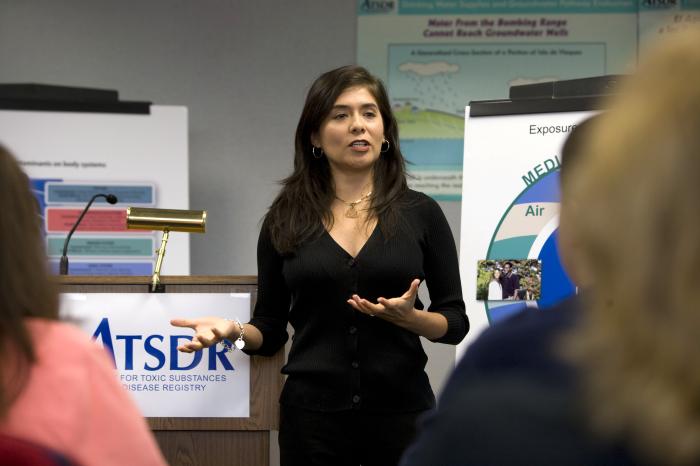What happens when a scenic tourist destination faces a tuberculosis (TB) outbreak? Sheboygan, WI found out in the spring of 2013 when a case of TB arose in a family in this city of nearly 50,000 on the shores of Lake Michigan. Although Sheboygan County averages three active cases of TB per year, it became clear as this year’s outbreak unfolded that this would not be an average year for Sheboygan.
 So begins the story of how a local health department (LHD) in southern Wisconsin responded to a severe TB outbreak in 2013. This story features a cast of characters that can be found in any Hollywood blockbuster: the villain (TB, and perhaps even the elected officials who resisted increased funding for the county’s TB program); the victim (the family impacted by TB); the hero (LHD staff who worked around the clock to mitigate the outbreak); and the unsuspecting secondary characters (local schoolchildren exposed to TB, worried parents and community members). Even the plot features many twists and turns—from discovering the severity and amount of TB cases, to facing legislative hurdles when seeking more resources, to the eventual happy ending where LHD staff mitigate the outbreak and share important lessons learned about preparedness practices.
So begins the story of how a local health department (LHD) in southern Wisconsin responded to a severe TB outbreak in 2013. This story features a cast of characters that can be found in any Hollywood blockbuster: the villain (TB, and perhaps even the elected officials who resisted increased funding for the county’s TB program); the victim (the family impacted by TB); the hero (LHD staff who worked around the clock to mitigate the outbreak); and the unsuspecting secondary characters (local schoolchildren exposed to TB, worried parents and community members). Even the plot features many twists and turns—from discovering the severity and amount of TB cases, to facing legislative hurdles when seeking more resources, to the eventual happy ending where LHD staff mitigate the outbreak and share important lessons learned about preparedness practices.
Like Sheboygan County Health and Human Services, LHDs have their own compelling stories to share. And sharing your story is becoming increasing critical. As funding for public health programs continues to dry up, LHDs can no longer afford to work “behind the scenes” for the people they serve and their funders. Decision makers in government need to hear success stories to understand the often invisible impact of public health, while residents can learn how their LHD interacts with, supports, and benefits the community. Many LHDs have discovered that the people they serve are often not aware of what they do. Explaining that work through compelling storytelling can bring the important work of LHDs into the spotlight.
In 2002, the Yellowstone City-County Health Department (now RiverStone Health) in Billings, MT surveyed their residents to learn what they knew about the department; findings showed that only 29 percent of those polled had ever heard of the health department. Leadership then embarked upon a rebranding effort that included a thorough staff buy-in process motivating employees to live the story of the health department and share the stories of its good work in the community. Ten years later, 88 percent of residents were able to identify the LHD’s name and services offered.
While success stories are important for building a positive image, a cautionary tale can sometimes make a more poignant story. When LHDs struggle with such challenges as extreme weather events, budget cuts, and dwindling resources, it can be valuable to use a story to illustrate the consequences of what could happen when LHDs don’t have the ability to rise to the occasion. Looking to historical examples for consequences of what happens when LHDs are not able to do their important work while providing a path forward with proposed solutions can help LHDs use cautionary tales to make a case for procuring and maintaining the funding and resources needed to meet potential challenges.
To help LHDs formulate their story and to learn from the stories of other LHDs, NACCHO has developed the new Stories from the Field website. As you think about how your LHD benefits the community and how you can communicate this impact, consider the following elements of a powerful story:
- Story Framework. Start with a lead sentence to capture the reader’s attention and set up the story. Provide sensory details to paint a picture of the situation and to engage the reader. Be sure to answer the 5 W’s of journalism (Who, What, Where, When, and Why) and provide a conclusion and a sense of impact on the community.
- Characters. Stories about individuals are more memorable than stories about programs. Illustrate the human interest factor and the emotional impact of your services. Use quotes from real people within the story and include pictures of people’s faces whenever possible.
- Writing Style. Use plain language to ensure that multiple audiences can comprehend your story. Include enough supportive details so that readers can understand what happened but without providing too much information so that the message is lost.
When you’re ready to tell your story, head over to the Stories from the Field website to get started or browse what other LHDs have shared. And once your story is ready, remember that is only the first step! Be sure to tell your story to community members by using your department’s communications channels; pitch your story to local media; or share your story with local, state, and federal partners. And don’t forget how important it is for all LHD staff to tell this story also, as seen in RiverStone Health’s success.
How does your LHD use storytelling? What resources would help your LHD use storytelling more effectively? Let us know in the comment box below.








